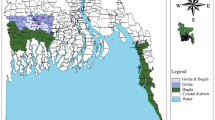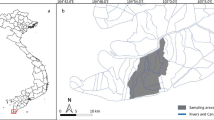Abstract
Mangroves are one of the most productive, diverse ecosystems on the planet and serve as a protective barrier for coastal areas. Shrimps have a productive correlation with mangroves habitat, thereby large-scale shrimp farming pose a serious threat to mangroves ecosystems. The present study was carried out to estimate the total area under shrimp farming in the intertidal regions of Kannur district. From the study, we have documented 140 shrimp ponds, which contributes to a total area of 524.4 ha. We found that active shrimp farming area in the district is 524.4 ha in 2020. The traditional shrimp farming method accounts for 60.6% of the total farmed area while non-traditional shrimp farming accounts for 36.9% of the total farmed area; both types are expanding fast in the district. Of the five major Rivers in the district, Kuppam River has the majority of the shrimp farms followed by Dharmadam River. Penaeus monodon, Litopenaeus vannamei and Penaeus indicus are the shrimp species cultivated in the district. Since shrimp farms are created by replacing the mangrove habitats in the intertidal region, mangroves of Kannur district are under threat and needs serious intervention for long term survival.








Similar content being viewed by others
Data availability
Not applicable.
References
Ashton EC (2008) The impact of shrimp farming on mangrove ecosystems. CAB Rev. https://doi.org/10.1079/PAVSNNR20083003
Bala Kiran P (2017) Mission mangroves Kannur. Mangal-Van. Mangrove Society of India, Goa, pp 41–54
Balakrishnan G, Peyail S, Ramachandran K, Theivasigamani A, Savji KA, Chokkaiah M, Nataraj P (2011) Growth of cultured white leg shrimp Litopenaeus vannamei (Boone 1931) in different stocking density. Adv Appl Sci Res 2(3):107–113
Barbier EB, Cox M (2004) An Economic analysis of shrimp farm expansion and mangrove conversion in Thailand. Land Econ 80(3):389–407
Berlanga-robles C A, Ruiz-luna A, Hernandez-Guzman R (2011) Impact of shrimp farming on mangrove forest and other coastal wetlands: the case of Mexico. Aquaculture and environment a shared destiny. http://www.intechopen.com/books/aquaculture-and-the-environment-a-shared-destiny
Bhattacharya P (2010) Comparative study of traditional vs scientific shrimp farming in West Bengal: a technical efficiency analysis. Indian Econ J. https://doi.org/10.1177/0019466220100206
Biao X, Tingyou L, Xipei W, Yi Q (2009) Variation in the water quality of organic and conventional shrimp ponds in a coastal environment from eastern China. Bulg J Agric Sci 15(1):47–59
Edwin S (2002) Mangrove ecosystem biodiversity: a case study. Central Marine Fisheries Research Institute, Cochin
FAO (2016) The state of world fisheries and aquaculture report. Food and Agricultural Organization of the United Nations, Rome
George G, Krishnan P, Mini KG, Salim SS, Ragavan P, Tenjing SY, Muruganandam R, Dubey SK, Gopalakrishnan A, Purvaja R, Ramesh R (2018) Structure and regeneration status of mangrove patches along the estuarine and coastal stretches of Kerala India. J for Res. https://doi.org/10.1007/s11676-018-0600-2
Hamilton SE (2011) The impact of shrimp farming on mangrove ecosystems and local livelihoods along the pacific coast of Ecuador. The University of Southern Mississippi, Hattiesburg
Harikumar G, Rajendran G (2007) Kerala fisheries—An over view of particular emphasis with on aquaculture. IFP Souvenir, Noida
Iqbal MH, Milon SRH (2018) Impact of land use for shrimp cultivation instead of crop farming: the case of southwest coastal region of Bangladesh. World Rev Bus Res 8(2):1–12
Jayanthi M, Gnanapzhalam L, Ramachandran S (2007) Assessment of impact of aquaculture on mangrove environments in the south east coast of India using remote sensing and geographical information system (GIS). Asian Fish Sci 20:325–338
Jayanthi M, Thirumurthy S, Muralidhar M, Ravichandran P (2018) Impact of shrimp aquaculture development on important ecosystems in India. Glob Environ Change 52:10–21. https://doi.org/10.1016/j.gloenvcha.2018.05.005
Jithendra K, Vijay KME, Rajanna KB, Mahesh V, Naik KAS, Pandey AK, Manjappa N, Pal J (2014) Ecological benefits of mangrove. Life Sci Leafl 48:85–88
Kathiresan K (2010) Importance of mangrove forests in India. J Coast Environ 1(1):11–26
Kumaran M, Anand PR, Kumar JK, Ravisankar T, PaulKumaraguru vasagam JKP, Vimala DD, Raja K (2016) A is pacific white shrimp (Penaeus vannamei) farming in India is technically efficient? A comprehensive study. Aquaculture 468:262–270. https://doi.org/10.1016/j.aquaculture.2016.10.019
Kumlu M, Turkmen S, Kumulu M (2010) Thermal tolerance of Litopenaeus vannamei (Crustacea: Penaeidae) acclimated to four temperatures. J Therm Biol 35:305–308. https://doi.org/10.1016/j.jtherbio.2010.06.009
Liao IC, Chien Y-H (2011) The pacific white shrimp, Litopenaeus vannamei, in Asia: the world’ s most widely cultured alien crustacean. In: Galil BS et al (eds) In the wrong place-alien marine crustacean; distribution, biology and impacts. Springer, Dordrecht
Mishra RR, Rath B, Thatoi H (2008) Water quality assessment of aquaculture ponds located in Bhitarkanika mangrove ecosystem, Orissa, India. Turk J Fish Aquat Sci 8:71–77
PÁez-Osuna F (2001) The environmental impact of shrimp aquaculture: causes, effects, and mitigating alternatives. Environ Manag 28(1):131–140. https://doi.org/10.1007/s002670010212
Pattanaik C, Prasad SN (2011) Ocean & coastal management assessment of aquaculture impact on mangroves of Mahanadi delta (Orissa), east coast of India using remote sensing and GIS. Ocean Coast Manag 54:789–795. https://doi.org/10.1016/j.ocecoaman.2011.07.013
Pillai NG, Harilala CC (2015) Status of mangrove diversity in the coastal environments of Kerala. Eco Chron 10(1):30–35
Preethy C M (2019) The systematics, floristics and ecology of selected mangroves of Kerala. Thesis submitted to the Department of Marine Biology, Microbiology & Biochemistry School of Marine Sciences, Cochin University of Science and Technology, Kochi
Primavera JH (1997) Socio-economic impacts of shrimp culture. Aquac Res 28:815–827
Primavera JH (2006) Overcoming the impacts of aquaculture on the coastal zone. Ocean Coast Manag 49:531–545
Rahman MM, Giedraitis VR, Lieberman LS, Akhtar T, Taminskienė V (2013) Shrimp cultivation with water salinity in Bangladesh: the implications of an ecological model. Univ J Public Health 1(3):131–142. https://doi.org/10.13189/ujph.2013.010313
Sadek MF, Nabawi SS (2021) Effect of water salinity on growth performance, survival %, feed utilization and body chemical composition of the Pacific white shrimp, Litopenaeus vannamei juveniles. Egypt J Aquat Biol Fish 25(4):465–478
Sahadevan P, Sureshkumar S (2020) Estimation of farmed shrimp production in Kerala. Int J Fish Aquat Stud 8(4):392–400. https://doi.org/10.22271/fish.2020.v8.i4e.2297
Sreelekshmi S, Veettil BK, Nandan SB, Harikrishnan M (2021) Mangrove forests along the coastline of Kerala, southern India: current status and future prospects. Reg Stud Mar Sci 41:101573. https://doi.org/10.1016/j.rsma.2020.101573
Treviño M, Murillo-Sandoval PJ (2021) Uneven consequences: gendered impacts of shrimp aquaculture development on mangrove dependent communities. Ocean Coast Manag. https://doi.org/10.1016/j.ocecoaman.2021.105688
Acknowledgements
The authors would like to acknowledge Kannur Kandal Project of Wildlife Trust of India and Apollo Tyres. The authors are grateful also to the Department of Geography-Kannur University, Kerala Fisheries department and Agency for the Development of Aquaculture in Kerala (ADAK). Also, sincere thanks to Aiswarya V V, MSc. student of the Department of Environmental Science, Bharathiar University, Coimbatore and Mohammed Shanid, MSc. student, Department of Ecology and Environmental Science, Pondicherry University. The authors also thank Ms. Navya K K, PhD scholar, Kerala Forest Research Institute and Mr. Sachin Chandran, PhD scholar, Payyanur College for their inputs.
Funding
This research received no external funding.
Author information
Authors and Affiliations
Contributions
Conceptualization, RM; methodology, RM.; BP.; software, SKP; validation, BP, RM, MT; formal analysis, BP, RM; investigation, BP, PMN; data curation, BP; writing-original draft preparation, BP, MT, PMN; writing-review and editing, RM, BP, SKP; project administration, RM; All authors have read and agreed to the published version of the manuscript.
Corresponding author
Ethics declarations
Conflict of interest
The authors declare that they have no conflict of interest.
Ethical approval
Not applicable.
Consent for publication
Not applicable.
Consent to participate
Not applicable.
Additional information
Publisher's Note
Springer Nature remains neutral with regard to jurisdictional claims in published maps and institutional affiliations.
Rights and permissions
Springer Nature or its licensor (e.g. a society or other partner) holds exclusive rights to this article under a publishing agreement with the author(s) or other rightsholder(s); author self-archiving of the accepted manuscript version of this article is solely governed by the terms of such publishing agreement and applicable law.
About this article
Cite this article
Bijith, P., Ramith, M., Megha, T. et al. Shrimp farms as a threat to mangrove forests in Kannur district of Kerala, India. Wetlands Ecol Manage 30, 1281–1289 (2022). https://doi.org/10.1007/s11273-022-09896-y
Received:
Accepted:
Published:
Issue Date:
DOI: https://doi.org/10.1007/s11273-022-09896-y




